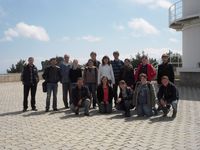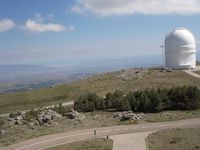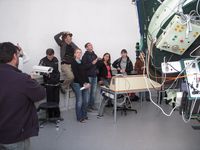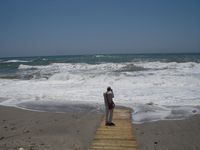The 2010 NEON school at Calar Alto Observatory
The 8th Neon observing school took place at Calar Alto Observatory (Spain) from June 16 to 27th, 2010. Sixteen students, from twelve different nationalities, used the 2.2m and the 1.2 telescopes to execute small research programs under the supervision of experienced tutors.
Before the start of the observations themselves, lectures explained the fundamentals of imaging, photometry, spectroscopy, etc...including the details of the instrumental set-up.
A visit of the facilities gave to the participants the opportunity to see the various telescopes, and to appreciate the nice location of the observatory.
 |
 |
The tutors guided the participants into the following programs:
- Santos Pedraz, with R. Anderson, E. Kiran, A. Kuzmicz, and L. Magill, studied the dynamical structure of giant and dwarf elliptical galaxies, and determined the age and metallicity of their stellar populations.
- David Galadi, with M. Adamow, P. Neyskens, C. Spiniello and S. Unterguggenberger, established the HR diagram of selected open clusters and determined their distances, ages and reddenings.
- Thomas Dall, with N. Galanakis, J. Gronowska, M. Habibi and A. Lalovic monitored the magnetic activity in close binary stars and looked for signs of hotspots and geometric distortions.
- G. Bergond, with G. Costigan, P. Lardo, J. Liska and P. Voigtlaender, studied a closeby spiral galaxy to confirm the existence of a bar, derive the star formation properties and confirm the suspected active galactic nucleus.
An intense activity of data-reduction was then necessary to extract the results. Thanks to a short break, in a location carefully selected by some of the lecturers,
the presentation of the scientific results went very smoothly the last day of the school. A general discussion, centered on the perspectives in the field of Astrophysics, concluded this intense and very effective event, leaving the participants with a fresh inpetus for their careers, and many new collaborators and friends.
More details on this school in particular , and on the Neon program in general, can be found on the following Web pages:
and www.iap.fr/neon/
 NEON
NEON
